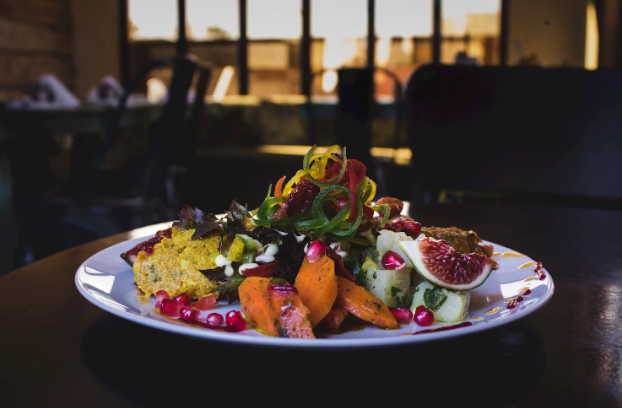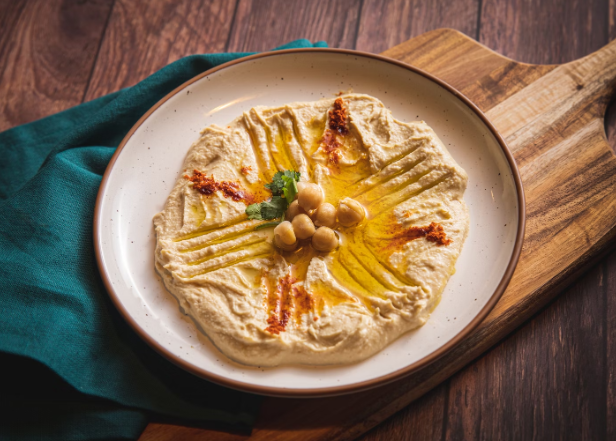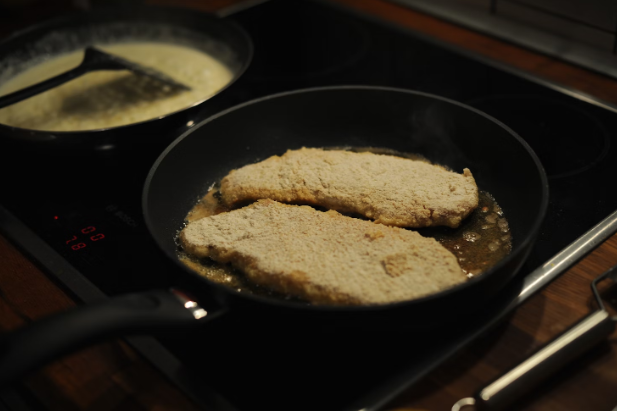
Looking for the best Israeli foods? This definitive list cuts through the noise to reveal the staples and favorites, from the creamy hummus enjoyed worldwide to lesser-known yet equally delightful dishes like Sabich.
Without the fluff, we dive into what to eat, where to find them, and how they contribute to Israel’s rich food landscape.
From the quintessential Hummus to the hearty Hamin, the vibrant Falafel to the sweet Malabi, each dish tells a story of Israel’s rich cultural mosaic.
The diversity in Israeli cuisine, from its Middle Eastern influences to the European classics, mirrors the diverse tapestry of its people and their shared history.
So the next time you find yourself savoring an Israeli dish, remember you’re not just enjoying a meal. You’re partaking in a centuries-old tradition that transcends borders and cultures.
1. Hummus: The Quintessential Israeli Staple

Picture walking along the vibrant streets of Tel Aviv, attracted by the alluring scent of a local delicacy – Hummus.
This unassuming yet universally loved dish is more than just food in Israel; it’s an emblem of shared cultural heritage, a symbol that resonates throughout the nation. Each region showcases its unique twist on the dish, with toppings like:
- Whole chickpeas
- Paprika
- Fried ground meat
- Sautéed mushrooms
This demonstrates the diversity and ingenuity of traditional Israeli food, an essential aspect of Israeli cuisine.
From its humble origins to the 13th century, Hummus has become a staple in Israeli cuisine. The legacy of this delightful blend of ground chickpeas, tahini sauce, olive oil, lemon juice, and garlic is visible in the Arab-Israeli villages acclaimed for their authentic Hummus recipe.
While you’re enjoying it as a traditional Israeli breakfast with warm pita bread or as a side dish with a falafel sandwich, the experience is enriched if you play casino for real money and take a trip to a local hummus venue in an Arab-Israeli village, each promising a distinctive and authentic hummus flavor.
2. Falafel: A Flavorful Street Food Favorite
Next up on our culinary sojourn is the flavorful favorite of Israeli street food – the Falafel. With its rich Egyptian origins, this popular dish has found a place in the heart of Israeli cuisine and has become emblematic.
Each bite of the typical Israeli falafel ball celebrates taste and texture. Crafted from a mixture of chickpeas or broad beans, the falafel is delicately seasoned with spices like cumin and coriander and enhanced with onions and parsley, offering a delectable crunch with every bite.
In Israel, Falafel is mainly savored as a filling in warm pita bread, paired with hummus, tahini sauce, and fresh vegetables, and occasionally garnished with fried eggplant or potatoes.
It’s also available as a platter with sides like fries and tabbouleh, making it a versatile choice for any meal. Streets of Jerusalem, Tel Aviv, and Haifa are dotted with vendors offering exemplary falafel, each promising a unique culinary delight that’s hard to resist.
3. Shakshuka: A Spicy Breakfast Delight

As dawn breaks, the air in Israeli homes fills with the tantalizing aroma of Shakshuka. This spicy breakfast delight, likely in Tunisia, a country in North Africa, has become a beloved dish across Israel and the Middle East, making breakfasts anything but ordinary.
Shakshuka’s name, which means ‘a mixture’ in Maghrebi Arabic, perfectly describes its composition.
At its heart are eggs, poached to perfection in a spicy tomato and bell pepper sauce. This sauce is seasoned with cumin, paprika, and cayenne, giving the dish its signature kick.
In a fascinating Jewish tradition, leftovers from the Sabbath dinner frequently transition into Sunday breakfast.
The remaining tomato stew from the previous night’s meal is typically repurposed into Shakshuka by incorporating eggs. This makes a delicious meal and ensures that nothing goes to waste.
Savored with crusty bread or pita, the Shakshuka is a perfect blend of flavors that kickstarts the day on a hearty note.
4. Sabich: An Iraqi-Jewish Fusion
From Ramat Gan’s vibrant streets to Tel Aviv’s quaint corners, you’ll find Israelis enjoying a delightful sandwich known as Sabich.
With its foundation in the Iraqi Jewish community, this dish was traditionally consumed on Shabbat mornings, reflecting its deep cultural roots.
In Israel, Sabich transformed from a cold Sabbath meal to a popular street food, gaining widespread popularity in the mid-20th century, partly due to its affordability.
At the heart of a Sabich sandwich lies:
- Crispy fried eggplant
- Hard-boiled eggs
- Tahini
- Israeli salad
- Hummus
- Parsley
- Amba—a tangy mango pickle of Indian origins
This fusion of flavors, wrapped in warm pita bread, makes it a favorite among locals and tourists.
Sabich is significant in the Israeli street food landscape, with vendors presenting unique versions, including organic alternatives and inventive additions like feta cheese and fried cauliflower.
5. Borekas: A Taste of the Balkans
Continuing our gastronomic adventure, we encounter a flavor of the Balkans that has been adopted by Israel – Borekas.
These savory pastries trace their origins to the Sephardic Jews who immigrated from Spain to Turkey in the late 1400s. They became known as hand-held pies, combining ‘empanada’ (Spanish) and ‘borek’ (Turkish).
In Israel, Borekas are a testament to the country’s rich culinary traditions. The dough, traditionally a Turkish ‘yufka’ is thin and resembles phyllo.
However, in Israel, Borekas can also be made with phyllo or puff pastry, resulting in pastries that range from crispy to buttery. The fillings are as diverse as the Israeli landscape itself, ranging from:
- Traditional cheese, potatoes, and spinach
- Other vegetarian options like eggplant and mushrooms
- During certain holidays, pumpkins and squash make an appearance
- Meat fillings take center stage in home-cooked meals.
Paired with warm tahini sauce, each mouthful of a Boreka is a pleasant revelation.
6. Jachnun: Yemenite Shabbat Morning Treat
Envision starting your Shabbat morning with the enticing scent of a traditional Yemenite delicacy – Jachnun.
With a rich buttery flavor, this pastry bread holds a special place in the Yemenite Jewish community, traditionally eaten after morning Shabbat prayers.
Though many Yemenite Jews outside of Aden were unfamiliar with Jachnun until they immigrated to Israel, it quickly became a popular Saturday morning food, appreciated for its portability and affordability during outings.
The making of Jachnun is a testament to the art of Israeli cooking. The dough, which includes:
- Flour
- Baking powder
- Salt
- Water
- Sugar
- Silan or honey
is stretched very thin and folded with butter before baking. This rolled dough is baked in a round pan at 225°F for 10-12 hours. Usually, hard-boiled eggs, known as haminados, are also cooked in the oven with Jachnun.
Accompanied by warm grated tomato, spicy Yemenite schug, and hard-boiled eggs, Jachnun has become an essential part of Israeli cuisine, available at stalls, eateries, and even via private kitchen sales, predominantly on Saturday mornings.
7. Cholent/Hamin: A Hearty Sabbath Stew
Venturing further into the culinary traditions of Shabbat, we come across a robust Sabbath stew – Cholent, alternatively known as Hamin. This dish originated in the Jewish cuisine of the French Ashkenazi during the 12th century and evolved from the Sephardic Sabbath stew known as hamin.
The spread of cholent and hamin across Europe was influenced by culinary techniques from Al-Andalus during the Christian Reconquista, with the term cholent deriving from Latin and Old French, indicating ‘that which is hot’.
The slow-cooked nature of cholent/hamin allows for a rich integration of flavors. The essential ingredients include:
- Meat
- Potatoes
- Beans
- Barley
The dish is traditionally brought to a boil before the Sabbath and then kept warm until mealtime.
Today, cholent features specialized cholenterias in Israel, serving as a Sabbath meal and as a social food in night hangout areas for Haredi men.
8. Malabi: A Sweet Rose-Infused Indulgence
Shifting our focus from the rich stews and flavorful pastries, we now explore the sweet treats of Israeli cuisine. And what better way to start than with Malabi – a sweet, rose-infused delight.
This creamy pudding has Persian origins and was later embraced and adapted by Israeli cuisine, where it is thickened with cornstarch and flavored with rosewater.
In Israeli culture, Malabi holds a place of significance during various festivals and is traditionally served by Sephardic Jews during customs like breaking the fast on Yom Kippur and celebrating weddings.
Israeli versions of Malabi have adapted traditional recipes, with some variations incorporating almond milk to comply with Kashrut and others featuring toppings like chopped pistachios and rosewater-rich syrups.
Having found its place in Tel Aviv’s dining scene, Malabi showcases the fusion of cultures within Israeli culinary traditions. It is commonly served chilled with distinct toppings and flavors, offering a refreshing end to a hearty meal.
9. Israeli Salad: A Fresh and Flavorful Side Dish
A comprehensive overview of Israeli cuisine would only be complete by discussing the Israeli Salad.
This fresh and flavorful side dish typifies Israeli cuisine with its base of finely diced cucumbers and tomatoes. Often augmented with ingredients such as:
- Onions
- Parsley
- Bell peppers
- Carrots
- Olives
- Radishes
The Israeli Salad is a tribute to the nation’s agricultural ethos.
For optimal flavor, the salad is prepared with fresh, ripe vegetables, uniformly chopped and dressed with a simple mix of:
- Olive oil
- Lemon juice
- Salt
- Pepper
Optional spices like za’atar and sumac can also be added. Each community introduces its own twist on the classic recipe by incorporating diverse ingredients such as preserved lemon peel or green chili peppers, making it a versatile element of Israeli dining.
The salad can be enjoyed throughout the day, from breakfast accompaniments to lunch and dinner sides, paired with pita, grilled meats, shakshuka, falafel, hummus, and more, underscoring its essential role in complementing a wide array of dishes.
10. Schnitzel: A European Classic with an Israeli Twist

As we draw closer to the end of our culinary expedition, we stumble upon a European classic warmly received by Israeli cuisine – the Schnitzel.
With its Austrian origins, this popular dish was introduced to Israeli cuisine by Central European immigrants before the country’s establishment.
However, adapting to local conditions, the veal originally used for schnitzel was replaced by more readily available and affordable chicken and turkey, with the schnitzel cut becoming a butchery staple in Israel.
In Israel, Schnitzel is fried in oil instead of butter to comply with Kosher dietary laws forbidding the mixing of dairy and meat.
Furthermore, Israeli Schnitzel has seen further customizations with breadcrumbs replaced by matzah meal during Passover and sesame seeds mixed into the breadcrumb coating, alongside the option of vegetarian versions like cabbage schnitzel.
Today, Schnitzel enjoys widespread popularity among children and adults alike. It is often served innovatively, such as the Shabbat Sandwich, making it an integral part of the Israeli culinary landscape.










